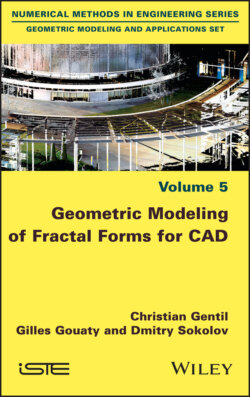Читать книгу Geometric Modeling of Fractal Forms for CAD - Christian Gentil - Страница 8
Оглавление
Preface
This work introduces a model of geometric representation for describing and manipulating complex non-standard shapes such as rough surfaces or porous volumes. It is aimed at students in scientific education (mathematicians, computer scientists, physicists, etc.), engineers, researchers or anyone familiar with the mathematical concepts addressed at early stages of the graduate level. However, many parts are accessible to all, in particular, all introductory sections that present ideas with examples. People with no prior background, whether they are artists, designers or simply curious, will be able to understand the philosophy of our approach, and discover a new universe of unsuspected and exciting forms.
Geometric representation models are mathematical tools integrated into computer-aided geometric design (CAGD) software. They make the production of numerical representations of forms possible. By means of graphical interfaces or programming tools, users can draw and/or manipulate these shapes. They can also test or evaluate their physical properties (mechanical, electro-magnetic, acoustic, etc.) by communicating geometric descriptions to further specific numerical simulation software.
The geometric representation model we present here is based on the fractal geometry paradigm. The principle behind this consists of studying the properties (signal, geometry, phenomena, etc.) at different scales and identifying the invariants from there. The objects are described as self-referential between two scales: each of the object features (namely, the lower scale level) is described as a reference to the object itself (namely, the higher scale). This approach is not conventional and often confusing at first. We come to perceive its richness and power very quickly, however. The universe of forms that can possibly be created is infinite and has still only partially been explored.
In this book, we present the mathematical foundations, so that the reader can access all the information to understand, test and make use of this model. Properties, theorems and construction methods are supplemented with algorithms and numerous examples and illustrations. Concerning the formalization, we have chosen to use precise and rigorous mathematical notations to remove any ambiguity and make understanding easier.
Readers unwilling to be concerned with mathematical formalisms can get to grips with the philosophy of our approach by focusing on the sections found at the beginnings of the chapters, in which ideas and principles are intuitively presented, based on examples.
This book is the result of 25 years of research carried out mainly in the LIRIS laboratories of the University of Lyon I and LIB of the University of Burgundy Franche-Comté. This research was initiated by Eric Tosan, who was instrumental at the origin of this formalism and to whom we dedicate this work.
Christian GENTIL
Gilles GOUATY
Dmitry SOKOLOV
February 2021
